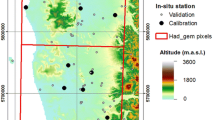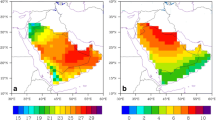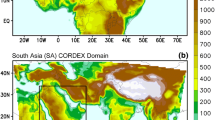Abstract
Climate change is one of the most important challenges for humanity at present, and its impacts are especially profound in semi-arid regions such as the Arabian Peninsula and Saudi Arabia in particular, as it directly impacts the fragile ecosystem of the region. The present study explores the changes in future temperature and precipitation patterns over the Arabian Peninsula for the two future time slices 2036–2065 and 2071–2100 with respect to the reference period (1976–2005), using state-of-the-art regional climate model simulations. Three global climate model (GCM) simulations from the WCRP Coupled Model Intercomparison Project Phase 5 (CMIP5) are downscaled with the International Centre for Theoretical Physics (ICTP) Regional Climate Model (RegCM4) over the Arabian Peninsula. Results indicate that the central parts of the Arabian Peninsula should get hotter in future compared to other parts of the Peninsula. This projected increase in temperature seems to happen mainly at the end of the twenty-first century. The projected temperature changes during mid-century fall in the range 1.0–1.5 °C under the RCP4.5 scenario and 2.0–2.5 °C under RCP8.5. Temperature changes by the end of the century are in the range 4–4.5 °C under RCP4.5 and 4.5–5.5 °C under RCP8.5. At the same time, this increase in temperature will affect the annual precipitation cycle as the precipitation during the dry season is expected to increase while the precipitation during the wet season is expected to decrease. RegCM simulations driven with boundary conditions from three GCMs are not consistent in producing future changes in precipitation over Saudi Arabia, which indicates that a careful interpretation of projected precipitation is required for its further use in impact and adaptation studies related to climate change.










Similar content being viewed by others
Notes
The Arabian Peninsula is the largest peninsula in the world occupying 3,237,500 km2, or 1,250,005 mi2. This Peninsula includes countries of Bahrain, Yemen, Qatar, Oman, UAE, Kuwait and Saudi Arabia. Kingdom of Saudi Arabia has population in excess of 33.4 million, accounting for 74% of total population as the total population of peninsula is 47.46 million. For further detail refer to (Arabian Peninsula Countries 2021 (worldpopulationreview.com) and http://oldweb.du.ac.in/uploads/departments/arabic/MA-Arabic-2nd-4th-Sem/Arabian%20Peninsula.pdf).
The Coordinated Regional Downscaling Experiment (CORDEX) vision is to advance and coordinate the science and application of regional climate downscaling through global partnerships (https://cordex.org/).
References
Almazroui M (2012) Dynamical downscaling of rainfall and temperature over the Arabian Peninsula using RegCM4. Climate Res 52:49–62
Almazroui M (2019a) Climate extremes over the Arabian Peninsula using RegCM4 for present conditions forced by several CMIP5 models. Atmosphere 10(11):675. https://doi.org/10.3390/atmos10110675
Almazroui M (2015) RegCM4 in climate simulation over CORDEX-MENA/Arab domain: selection of suitable domain, convection and land-surface schemes. INTERNATIONAL JOURNAL OF CLIMATOLOGY Int J Climatol. https://doi.org/10.1002/joc.4340
Almazroui M (2019b) Temperature changes over the CORDEX-MENA domain in the 21st century using CMIP5 data downscaled with RegCM4: a focus on the Arabian Peninsula. Adv Meteorol 5395676.https://doi.org/10.1155/2019b/5395676
Almazroui M (2020a) Changes in temperature trends and extremes over Saudi Arabia for the period 1978–2019. Advances in Meteorology, Article ID, pp. 1–21. https://doi.org/10.1155/2020a/8828421
Almazroui M (2020b) Summer maximum temperature over the gulf cooperation council states in the twenty-first century: multimodel simulations overview. Arab J Geosci 13:477. https://doi.org/10.1007/s12517-020-05537-x
Almazroui M (2020c) Rainfall trends and extremes in Saudi Arabia in recent decades. Atmosphere 11(9):964. https://doi.org/10.3390/atmos11090964
Almazroui M, Islam MN, Saeed S et al (2017) Assessment of uncertainties in projected temperature and precipitation over the Arabian Peninsula using three categories of CMIP5 multimodel ensembles. Earth Syst Environ 1(23):1–13. https://doi.org/10.1007/s41748-017-0027-5
Almazroui M, Islam MN, Saeed S et al (2020) Future changes in climate over the Arabian Peninsula based on CMIP6 multimodel simulations. Earth Syst Environ 4:611–630. https://doi.org/10.1007/s41748-020-00183-5
Almazroui M, Hasanean HM, Al-Khalaf AK, Abdel Basset H (2013a) Detecting climate change signals in Saudi Arabia using mean annual surface air temperatures. Theor Appl Climatol 113:585–598
Almazroui M, Abid MA, Athar H, Islam MN, E. M. (2013b) Interannual variability of rainfall over the Arabian Peninsula using the IPCC AR4 global climate models. Int J Climatol 33:2328–2340. https://doi.org/10.1002/joc.3600
Almazroui M, Islam MN (2019) Coupled model inter-comparison project database to calculate drought indices for Saudi Arabia: a preliminary assessment. Earth Syst Environ 3:419–428. https://doi.org/10.1007/s41748-019-00126-9
Alsarhan A, Zatari T, Al-Asaly M, Mirza K et al (2016) Third National Communication of the Kingdom of Saudi Arabia. Available at: https://unfccc.int/files/national_reports/non-annex_i_natcom/application/pdf/saudi_arabia_nc3_22_dec_2016.pdf
Baek HJ, Lee J, Lee H et al (2014) Climate change in the 21st century simulated by HadGEM2-AO under representative concentration pathways. Asia-Pac J Atmos Sci 14:1873–1890. https://doi.org/10.1007/s10113-012-0400-8
David Gampe, Josef Schmid RL (2019) Impact of reference dataset selection on RCM evaluation, bias correction, and resulting climate change signals of precipitation. J Hydrometeorol 20(9), 1813–1828.https://doi.org/10.1175/JHM-D-18-0108.1
Davis N, Bowden J, Semazzi F, Xie L, Önol B (2009) Customization of RegCM3 regional climate model for eastern Africa and a tropical Indian ocean domain. J Clim 22:3595–3616. https://doi.org/10.1175/2009JCLI2388.1
Donat MG, Peterson TC, Brunet M, King AD et al (2014) Changes in extreme temperature and precipitation in the Arab region: long-term trends and variability related to ENSO and NAO. Int J Climatol 34(4):581–592. https://doi.org/10.1002/joc.3707
Esch E, Roeckner G, Bäuml L et al (2003) The atmospheric general circulation model ECHAM5 - Part I. Hamberg
Giorgi F, Anyah RO (2012) The road towards RegCM4. Climate Res 52:3–6. https://doi.org/10.3354/cr01089
Giorgi F, Jones CAG (2009) Addressing climate information needs at the regional level: the CORDEX framework. WMO Bulletin, 58(3), 175–183. Available at: https://public.wmo.int/en/bulletin/addressing-climate-information-needs-regional-level-cordex-framework
Holtslag B, Bruijn EIF, Pan HL (1990) A high-resolution air-mass transformation model for short-range weather forecasting. Mon Weather Rev 118(8):1561–1575. https://doi.org/10.1175/1520-0493(1990)118%3c1561:AHRAMT%3e2.0.CO;2
IPCC (2021) The Working Group I contribution to the Sixth Assessment Report, Climate Change 2021: The Physical Science Basis was released on 9 August 2021
Jianping H, Ji M, Xie Y, Wang S, He Y, Ran J (2016) Global semi-arid climate change over last 60 years. Clim Dyn 46:1131–1150. https://doi.org/10.1007/s00382-015-2636-8
Katragkou E, García-Díez M, Vautard R, Sobolowski S, Zanis P (2015) Regional climate hindcast simulations within EURO-CORDEX: evaluation of a WRF multi-physics ensemble. Geoscientific Model Development 8:603–618. https://doi.org/10.5194/gmd-8-603-2015
Nissen KM, Leckebusch GC, Pinto JG et al (2014) Mediterranean cyclones and windstorms in a changing climate, Regional Environment Change, 14: 1873–1890. Available at: https://doi.org/10.1007/s10113-012-0400-8
Pal J, Small EE, Eltahir EAB (2000) Simulation of regional-scale water and energy budgets: Representation of subgrid cloud and precipitation processes within RegCM. J Geophys Res 105:29579–29594
Pal J, Eltahir E (2016) Future temperature in southwest Asia projected to exceed a threshold for human adaptability, Nature Clim Change, 6, 197–200. Available at: https://doi.org/10.1038/nclimate2833
Piani C, Haerter JO, Coppola E (2010) Statistical bias correction for daily precipitation in regional climate models over Europe. Theoret Appl Climatol 99:187–192. https://doi.org/10.1007/s00704-009-0134-9
Platon Patlakas, Christos Stathopoulos, Helena Flocas, Christina Kalogeri, and GK (2019) Regional climatic features of the Arabian Peninsula, Atmosphere 10(4). https://doi.org/10.3390/atmos10040220.
Safriel U, Adeel Z (2008) Development paths of drylands: thresholds and sustainability. Sustain Sci 3(1):117–123
Salahuddin Q, Nazeer K (1994) Estimation of climatic transition in Riyadh (Saudi Arabia) in global warming perspectives. Geo Journal, 33(4), 423–433. Available at: https://www.jstor.org/stable/41146242
Tarawneh YQ, Chowdhury S (2018) Trends of climate change in Saudi Arabia: implications on water resources. Climate 6(8):1–19. https://doi.org/10.3390/cli6010008
Acknowledgements
The authors acknowledge the King Abdulaziz University for its support and World Climate Research Programme, which, through its Working Group on Coupled Modelling, coordinated and promoted CMIP5. We thank the climate modelling groups for producing and making available their model output, the Earth System Grid Federation (ESGF) for archiving the data and providing access and the multiple funding agencies that support CMIP5 and ESGF. The CRU and GPCC are acknowledged for providing data through their websites. Computation for the work described in this paper was performed using Aziz Supercomputer at King Abdulaziz University’s High-Performance Computing Center, Jeddah, Saudi Arabia.
Author information
Authors and Affiliations
Corresponding author
Ethics declarations
Conflict of interest
The authors declare no competing interests.
Additional information
Responsible Editor: Biswajeet Pradhan
Rights and permissions
About this article
Cite this article
Almazroui, M., Alowaibdi, T. & Hasanean, H. Dynamical downscaled CMIP5 scenario–based future climate changes over the Arabian Peninsula. Arab J Geosci 15, 951 (2022). https://doi.org/10.1007/s12517-022-10247-7
Received:
Accepted:
Published:
DOI: https://doi.org/10.1007/s12517-022-10247-7




